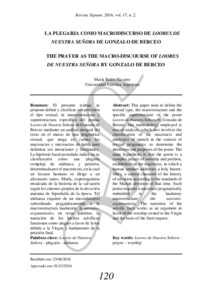Please use this identifier to cite or link to this item:
https://repositorio.uca.edu.ar/handle/123456789/10342| Título: | La plegaria como macrodiscurso de Loores de Nuestra Señora de Gonzalo de Berceo The prayer as the macro-discourse of Loores de Nuestra Señora by Gonzalo de Berceo |
Autor: | Navarro, María Belén | Palabras clave: | PLEGARIA; ALABANZA; Gonzalo de Berceo, ca1195-ca1265; POESIA; LITERATURA MEDIEVAL | Fecha de publicación: | 2016 | Editorial: | Associação Brasileira de Estudos Medievais | Cita: | Navarro, M. B. La plegaria como macrodiscurso de Loores de Nuestra Señora de Gonzalo de Berceo [en línea]. Revista Signum,. 2016, 17, (2). Disponible en: https://repositorio.uca.edu.ar/handle/123456789/10342 | Proyecto: | Los Loores de Nuestra Señora, de Gonzalo de Berceo: articulación textual y sentido global | Resumen: | Resumen: El presente trabajo se propone definir y clasificar con precisión el tipo textual, la macroestructura y superestructura específica del poema Loores de Nuestra Señora de Gonzalo de Berceo mediante un análisis integral del texto en el marco de una pragmática textual, que tenga en cuenta los macroactos y microactos de habla para delimitar sus intenciones y finalidades. La hipótesis basal postulada radica en su clasificación como una plegaria compleja de alabanza y petición, determinada por el macrotexto, en la cual un locutor humano se dirige a un alocutario santo, María, coprotagonista ensalzada de la historia de la salvación según los cánones propios de la devoción mariana de hiperdulía de la época. Tal alabanza requiere de un microdiscurso subordinado pragmáticamente a la macroestructura laudatoria: la narratioargumentatio, en otras palabras, la narración de los hechos salvíficos funcionan como alegato a favor de la loa debida a la Virgen y fundamento de la petición final. Abstract: This paper aims to define the textual type, the macrostructure and the specific superstructure of the poem Loores de Nuestra Señora by Gonzalo de Berceo. The methodology employed is textual analysis, which also involves the classification of the macroacts and microacts of speech in the context of textual pragmatics to determine the intentions and purposes of the poem. The main hypothesis is that the poem is a complex prayer of worship and petition, established on the macrotext, in which a human speaker addresses a holy hearer, Mary, a central character of the history of salvation according to the standards of the Marian devotion of that time. Such praise requires a microtext pragmatically embedded to the laudatory macrostructure: the narratioargumentatio. The narration of the salvific facts works as an argument in favor of the worship owned to the Virgin and the basis of the final request. |
URI: | https://repositorio.uca.edu.ar/handle/123456789/10342 | ISSN: | 2177-7306 | Disciplina: | LITERATURA | Derechos: | Acceso abierto | Fuente: | Revista Signum Vol. 17, No.2, 2016 |
| Appears in Collections: | Artículos |
Files in This Item:
| File | Description | Size | Format | |
|---|---|---|---|---|
| plegaria-como-macrodiscurso-loores.pdf | 348,66 kB | Adobe PDF |  View/Open |
Page view(s)
289
checked on Apr 30, 2024
Download(s)
289
checked on Apr 30, 2024
Google ScholarTM
Check
This item is licensed under a Creative Commons License

